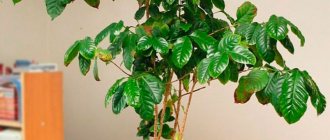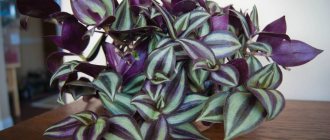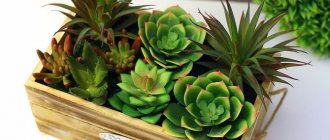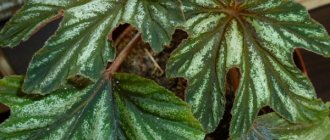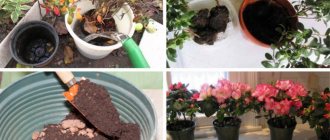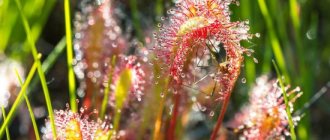Indoor trees are very popular in modern decorative floristry. Compared to regular flowers, they require significantly less care. At the same time, a small tree looks impressive in almost any room.
Dear readers! For you, we have created communities on social networks in which useful articles and interesting ideas are published several times a day! Subscribe and receive useful content in a convenient format!
In today's article we will talk about one of the most popular indoor woody plants, the coffee tree.
Botanical description and homeland of the plant
The plant is part of the Rubiaceae family. The tree's homeland is ancient Abyssinia (modern Ethiopia). Now the coffee tree can be found even in the wild in South America, Asia, and other areas of Africa.
Indoor varieties are widespread everywhere.
At home, coffee is a low bushy tree that grows mainly in several thin trunks. The plant does not branch much. The process of formation of additional shoots usually begins only in the 2nd year. Coffee has large oval leaves with a pointed tip. The surface of the leaf blade is slightly convex with clearly visible veins. The color is green.
Coffee blossoms and bears fruit. The inflorescence is umbellate and consists of small white flowers. After flowering, a fruit is formed, which turns red when ripe. The berry is covered with a small crust, inside there is sweet and sour pulp and a couple of seeds-grains, from which the famous drink is prepared.
Beneficial features
The coffee tree seeds contain valuable microelements and substances. In this case, caffeine is considered the most famous and active substance. Caffeine-based drugs and drinks are produced that have an exciting, stimulating and tonic effect. They are used in the treatment of fatigue, headaches, nervous exhaustion and other diseases. Coffee has a rich, unique aroma and taste, which is why it is widely used in cooking for preparing a variety of drinks, ice cream, desserts, and baked goods.
Coffee tree - secrets of growing at home.
Caring for your coffee tree after purchase
Before you go to the store and buy yourself a new green pet, you should think about where to put it. Remember that coffee is a tree, and although it will not grow to several meters at home, it still needs space.
So, you bought yourself a coffee seedling. First of all, he must be quarantined. This is necessary so that the plant gets used to the new conditions. Also during this time you can find out whether the plant is sick and whether pests live on it.
In addition to quarantine, the coffee tree can be replanted. A transplant is required in the following cases:
- Several coffee cuttings sit in one container;
- The pot is too low quality;
- The soil mixture is a nutrient substrate, not ordinary soil.
ON A NOTE. Don't worry if all the leaves have fallen off the tree after replanting. This is due to the fact that all the plants in stores are “overfed”. Very soon the coffee will return to normal.
General cultivation features
If you start an Arabica coffee tree, you need to allocate a separate place for it on the windowsill, since it does not tolerate the presence of other plants. Arabica will not bloom or bear fruit.
Tropical plants do not like sudden temperature changes. Throughout the year the thermometer shows from 19 to 26 degrees. This is one of the reasons to plant Arabica on your windowsill - the climate of the apartment is well suited for the capricious plant.
The coffee tree responds very well to fertilizing. In nature, for example, in Ethiopia, Arabica grows on volcanic soils with weak acidity. This is nutrient-rich soil, so fertilizers are not used there. In the apartment you will have to use both organic and mineral complex mixtures. The coffee tree loves soil rich in humus.
The Arabica bush does not tolerate being moved, even if they want better lighting. During budding, the tree may shed its flowers. This is one of the conditions for obtaining a harvest. You should immediately place it on the south or east side and not move it any longer.
Interesting! If you still need to move the tree to another room, then cover it with gauze in one layer and leave it for a week. Then they move it to another place, but the gauze is not removed for another week. In this way, it is possible to deceive the plant, which for two weeks receives only diffused light and gets used to the new conditions.
It is advisable that there are no heating radiators nearby that dry out the air. The second condition is the humidity of the air and the earthen coma. The soil should never dry out completely. In nature, Arabica trees bloom after each rainy season, when the water washes away the nutrients so the plants can absorb them in the liquid.
Anyone who has grown Arabica coffee at home has tried all the methods. There are only two of them - plant freshly harvested grains in the ground or root a cut cutting. Each method has its own advantages and disadvantages.
Growing conditions
In general, the coffee tree does not pose impossible tasks for the grower. The plant needs quite ordinary care and growing conditions, but with its own characteristics.
Temperature
Coffee loves warmth, but does not handle heat very well. The ideal temperature is 23 – 25 degrees. In winter, you can slightly reduce the temperature, but only to 15 degrees. If the temperature drops further, the coffee may shed its leaves.
IMPORTANT! Protect the tree from sudden changes in ambient temperature and drafts. Both have a negative effect on flowering and fruiting.
Air humidity
Coffee prefers high air humidity. In a dry climate, the tree does not feel well, often gets sick, and blooms poorly.
Additionally, it is recommended to spray the plant with a spray bottle. In the summer, you can periodically “bathe” the coffee tree.
IMPORTANT! In winter, the tree tub should be placed away from radiators, as the tips of the leaves will begin to wither due to dry air.
Coffee also loves fresh air, so we recommend periodic ventilation in winter. The main thing is to make sure that there is no draft, as this can make the plant sick.
Coffee tree after spraying
Lighting
The coffee tree comes from Africa, which means it loves light. But it is still undesirable to expose it to direct sunlight. It would be ideal to shade the plant a little. To do this, you can cover the windows with paper, use tulle or Roman blinds.
ON A NOTE. If your apartment does not have the right place with sufficient lighting, then the coffee tree can be placed under fluorescent lamps.
The soil
For a coffee tree, it is better to choose acidic soil (with a pH level less than 7). If you prepare the soil yourself, then follow these proportions: 2 parts acidic peat, 1 part distilled, 1 part sand, 1 part each leaf and greenhouse soil.
Pot
It is equally important to choose the right pot. In a container that is too small, the plant will be cramped. The roots will quickly fill the entire volume, and the coffee will begin to hurt. If it is too large, on the contrary, the tree will not be able to receive all the nutrients when watering and feeding.
It follows from this that you need to choose a medium-sized pot for the plant, so that it is not cramped, but there is space to grow.
In what cases is support needed?
Sometimes your green pet may need support. These are mainly cases when the plant has too thin shoots, as well as after transplanting into a new pot, when the tree has not yet taken root.
Choosing a place to put it
Indoors, the coffee tree is best placed near a south window. If this is not possible, then place the tree on the east or west window.
It is not recommended to place the pot in dark corners or in the back of the room. Lack of lighting negatively affects the decorative qualities of the plant.
In late spring and summer, the coffee tub can be moved to the loggia or taken out to the terrace. The tree will really like this, as it will be provided with a sufficient amount of light and fresh air.
What does it look like in the interior?
The coffee tree is not just another flower in a pot. This is part of the interior decor of any room. The plant looks beautiful in a modern studio apartment, office, and bedroom. The coffee tree is also great for decorating public spaces: cafes, reception areas, corridors, conservatories, etc.
How to start a coffee tree at home
The best option for your home is an Arabica coffee tree. Robusta, although less fastidious, requires cross-pollination, so it is more difficult to get it to bear fruit. If you don’t have enough space in your house, you can buy dwarf Arabica beans or sprouts, one of the most popular varieties is Albert.
There are 3 ways to get a coffee tree:
- sprout from a grain;
- grow a cutting;
- buy in the store.
Growing coffee trees from beans
Ordinary green coffee beans intended for making a drink are unsuitable for germination: they have been collected too long ago and, in addition, they are subjected to special processing.
Coffee beans harvested no more than 1–1.5 months ago have the best germination. Such seeds can be purchased in online stores.
But it is best to ask the owner of the coffee tree for a ripe berry. Nature itself has covered the coffee beans with juicy pulp, so there is no need to soak them.
The optimal temperature for seed germination is from +19 to +24 °C.
Soil composition for sowing:
- 1 part peat;
- 1 part sand;
- 2 parts of turf land.
- The soil mixture must be prepared 2 weeks before sowing.
- Sowing berries:
- the soil in the pot should be moist;
- The berry is placed on its side (flat side down) in a hole approximately 1 cm deep, sprinkled with earth, which is lightly pressed;
- The pot is covered with a jar and placed in a warm, bright place (but it should not be exposed to direct sunlight).
It will take a long time for the berries to germinate, about 3–6 months. But 2 sprouts can appear from the grains at once. They are kept under glass until the cotyledon leaves shed their hard shell. Periodically, condensation is wiped off the walls of the jar. When the cotyledon leaves expand, the plant gradually begins to adapt to the drier climate of the room.
Grains freed from pulp germinate somewhat faster (after 1–3 months).
Sowing the grain:
- The seeds are soaked for 30 minutes in a very weak solution of potassium permanganate, and then for another 30 minutes in aloe juice.
- The grains are planted in the same way as berries: in a hole 1 cm deep, flat side down.
- After planting, the soil is moistened abundantly and the pot is covered with a jar.
Coffee trees grown from beans bloom in the 3rd or 4th year.
Propagation of coffee trees by cuttings
To plant cuttings, prepare a substrate in advance from peat and sand, taken in a 1:1 ratio.
Planting a cutting:
- A branch with 2 pairs of leaves is cut 2.5–3 cm below the bud. The cut should be oblique, it is treated with “Kornevin” or another rooting stimulator.
- The cuttings are vertically stuck into well-moistened soil so that the lower buds are covered with substrate.
- The cutting is covered with a plastic bag in which a small hole is cut. Periodically through this hole the cuttings are sprayed with warm water.
A rooted cutting can be replanted only after a new pair of leaves appears. Coffee trees grown from cuttings bloom in the 2nd or 3rd year.
Buying a coffee tree in a store
Coffee trees sold in stores usually look healthy in appearance: they have dark, shiny leaves and often already have flowers or berries. But it should be remembered that purchased plants are often overfed with fertilizers.
Therefore, you should not be surprised if the tree at home begins to turn yellow and shed its leaves. With normal care it will recover. The main thing is that there are no spider mites. Having brought the tree home, you need to “quarantine” it, separating it from other indoor plants. If spider mites are detected, the coffee tree must be treated with an insecticide. If the plant is healthy, it is replanted.
Flowering conditions
The coffee tree blooms in spring. It forms umbrella-shaped inflorescences consisting of small white flowers. At the same time, the tree emits a pleasant aroma.
REFERENCE. The coffee tree fades very quickly. Don't miss this amazing moment!
Flowering
You can also help the plant bloom. To do this, gently shake the branches on which the inflorescences appeared. Another way is to take a cotton swab or soft brush and touch the flowers. This will cause artificial pollination.
After flowering, fruits begin to set. They ripen almost throughout the spring-summer period, and in some cases the process can even take 1.5 – 2 years.
IMPORTANT! In order for coffee to bloom bright and memorable, it needs to be allowed to rest in winter. During the dormant period, you will have to reduce watering and eliminate the application of fertilizers. You also need to slightly reduce the temperature.
Brief description of cultivation
- Temperature . In the spring-summer period - from 20 to 30 degrees, and in winter - from 12 to 15 degrees.
- Air humidity . Should be increased (approximately 70 percent).
- Illumination . Supplementary lighting or diffused sunlight. The best option for the plant is a western or northern window sill.
- Watering . The substrate is moistened with well-settled softened water. In the warm season, watering is carried out once every couple of days (at least), and in the winter months - after the top layer of the soil mixture has dried.
- Substrate . Should be slightly acidic. A high-quality drainage layer is made at the bottom of the pot.
- Fertilizer . Fertilizing with organic fertilizer is carried out once every 15 days. At the same time, mineral fertilizers are added to the substrate once every 2 weeks.
- Transplant . It is carried out only when the roots no longer fit into the pot (approximately once every 3 years).
- Reproduction . Seed and vegetative methods.
- Features of care . The plant reacts extremely negatively to even a small draft and stagnation of moisture in the roots. In winter, the bush needs rest, and it is removed away from operating heating devices.
Coffee tree: how to properly care for and replant
Transfer
While the coffee tree is young, it is replanted every year. Upon reaching the age of three, the growth of the tree slows down. Accordingly, the frequency of transfers is reduced. It will need to be carried out approximately once every four years.
Replanting a plant is no different from a similar process carried out with other indoor flowers. On the contrary, replanting a coffee tree is even easier, since it has stronger roots.
Saplings
ON A NOTE! But this does not mean that you need to work sloppy. Still, try not to damage the root system.
- First of all, prepare a pot of suitable size, proper soil and drainage.
- First, place the drainage in a new container.
- Then remove the plant from the old pot. This must be done using the transshipment method.
- If old drainage is stuck to the bottom, carefully shake it off.
- Carefully remove the old soil.
- If you want to plant the cuttings in different pots, then place the entire plant in a bowl of warm water and carefully wash off the remaining soil. Next, carefully separate the tangled roots of each stem.
- Sprinkle the drainage in the new pot with soil and place the seedling there.
- Carefully add soil to the desired level and water the transplanted plant.
IMPORTANT! If you are not replanting, then change the top layer of soil. This is necessary so that the earth does not become depleted.
Varieties of coffee trees
Today there are many varieties and varieties of coffee. Each of them has certain characteristics.
Arabica coffee tree
Under natural conditions, the Arabian tree grows on rocky hills or volcanic plateaus. Mature plants produce up to 5 kg of grains per year.
Note! When grown at home, the crop can reach a height of 1.5 m. With proper care of the Arabica coffee indoor plant, you can get 500 g of fruit.
Flower growers often grow the Albert variety. This is a dwarf crop that is intended for indoor cultivation. It is an evergreen tree that, with proper care, can bloom twice a year - in spring and summer.
Robusta coffee tree
The plant was discovered in the Congo Basin back in the 18th century. The characteristic features of the crop include resistance to temperature fluctuations, the ability to grow in depleted soil, and high yield.
Robusta is considered an excellent energy drink, but is significantly inferior in taste to Arabica. The coffee tree is small in size. In appearance, it more closely resembles a shrub that grows up to 2-3 m. The leaves of the plant are covered with fluff and have a rich green color. The culture has a wonderful aroma.
For your information! Grain ripening occurs within 9-11 months. During the season you can get up to 1.5 kg of fragrant fruits from the plant.
Liberica coffee tree
This coffee variety is easy to grow at home. To regulate the height of the plant and form a beautiful crown, it needs to be pruned. The leaves reach a length of 40 cm.
The inflorescences are white. After flowering is completed, fruits with large seeds are formed. Ripe fruits have a spectacular appearance. They have a scarlet or orange tint.
Coffee tree Excelsa
Under natural conditions, the plant can reach 20 m. When grown on plantations, plants are pruned to 1.5 m to facilitate harvesting. The trees have wide leaves with smooth edges. Large flowers with a spicy aroma.
Note! Excelsa beans have an unusual aroma. It is richer and fruitier
The fruits have a mild taste and contain a minimal amount of caffeine. There are also varieties that contain no caffeine at all.
The advantages of the plant include resistance to diseases and pests. The culture is often used for grafting onto other varieties, as it helps to increase viability.
Reproduction
Coffee is propagated by seeds or vegetatively. Below we will talk about each method in a little more detail.
Propagating a coffee tree from seeds
If you are an experienced gardener, you can try to grow a coffee tree from an ordinary coffee bean.
Fruit
REFERENCE. Roasted grains will not work.
First of all, it is necessary to destroy the “shell” on the grain. To do this, you can carefully file it or soak it in a solution of hydrochloric acid. We recommend making careful cuts, as the use of chemicals can damage the seed itself.
Next, the seeds are washed with potassium permanganate and placed in a solution of a growth stimulator. Any will do.
You need loose soil, consisting of turf soil, sand, ash and peat. The seeds are placed in the soil and pressed down slightly. Then the plantings are watered and covered with film, a transparent plastic lid or a plastic bag. This is how we create a greenhouse effect inside.
There is no need to place the pot directly in the sun, but it should not be placed in the shade either. A warm place near the windowsill is best.
The seeds will germinate in about a month.
The first transplant is carried out when foliage appears.
How to propagate vegetatively
The vegetative method is the most effective and requires much less labor.
- First of all, prepare the cuttings. They should be about 8 – 10 cm long and have at least 2 buds.
- Then place the cuttings in containers and keep them warm.
- To make rooting go better, put a plastic bag on top or cover it with a jar. This will create a greenhouse effect.
- Periodically water the soil and ventilate the seedlings.
- Once the plants have taken root, they should be transplanted into permanent pots.
Propagation by cuttings
How to care for your Arabica coffee houseplant
The main thing that will help you grow a strong and healthy coffee tree, and in the morning enjoy the taste of a drink made from a homemade product, is creating optimally comfortable conditions for its development (sufficient light, water and proper fertilizing). If these factors are lacking, the coffee plant may simply die. Then your expectations and efforts will not be justified, and the time devoted to this activity will simply be wasted. Therefore, each point of the recommendations should be strictly followed.
Plant location and lighting
Light is important, but not of paramount importance for a flower. He will feel great in the eastern and western parts of the apartment. If you place your exotic “guest” on the windowsill on the north side, be prepared for the coffee tree’s growth to slow down sharply. Also, the plant does not tolerate direct exposure to ultraviolet rays on the leaves. This is especially true for young seedlings whose age does not exceed 2 years.
Important: it is highly undesirable to move the coffee tree from one place to another. Even the slightest rotation of the pot a few degrees can cause leaves to fall off. Therefore, it is recommended to think in advance about its placement in the house.
Watering
The coffee tree is a houseplant that loves high humidity. Its watering from spring to autumn should be done abundantly, as the soil dries out, but in winter it can be slightly reduced. The only exception is summer. On especially hot days, you should stop watering the plant altogether, otherwise the tree may begin to hurt, and unsightly dark spots will appear on the leaves.
It is also necessary to monitor the water temperature. Use settled water (preferably melt or rain). It is also necessary from time to time to wipe the leaves of the plant from dust with a sponge or rag soaked in a soapy solution.
Air humidity
For better development of the coffee plant, it is necessary to maintain optimal air humidity in the room. If you notice that the ends of the leaves constantly dry out, then this is a clear sign that the flower is uncomfortable. Therefore, it is better to spray the tree daily with a spray bottle.
Advice: sometimes such “water procedures” are not enough for a plant, and it would be better to place the pot with it in a deep basin, the bottom of which can be covered with pebbles and filled with water. Don't forget to also make a drainage layer.
Optimal temperature
Arabica coffee is a houseplant that bears fruit with aromatic edible beans. Warmth and fresh air are especially favorable for this variety. Therefore, the room where the tree “lives” must be ventilated several times a day, and in hot weather, use a table fan.
The plant grows and develops normally in the spring-summer season if the room temperature is maintained at room temperature, but not higher than 250C, and in winter - not lower than 150C.
Soil type
The optimal composition of the soil for growing a coffee tree should have an acidic environment (with pH < 7). An ideal substrate consisting of turf and deciduous soil, manure, sand and peat. You can also add a small amount of bone meal or ash to the soil mixture. This will only benefit your plant.
Tip: to better maintain the acidity of the soil, you can periodically add sphagnum moss to it, which should first be crushed.
How to fertilize
As a top dressing, an excellent solution would be to use organic matter (water infusion of mullein, humus) or mineral fertilizers (nitrogen, phosphorus, potassium). They are applied to the soil once every two weeks from April to September. This schedule was not chosen by chance, because it is at this time that the plant actively grows.
There are several ways to feed:
- External (when fertilizer is applied directly to the leaves of the coffee tree).
- Root liquid (nutrients are dissolved in water, and then the resulting composition is watered onto the soil).
- Root solid (the soil is sprinkled with insoluble mineral fertilizers, and then under the influence of regular watering they penetrate into the soil).
How coffee blooms
The flowering process of a coffee plant is captured in many photos, because this is the result of painstaking work that the gardener wants to share. By organizing proper care for your home tree, you will also see beautiful buds, from which fruits will soon ripen. Just be patient - this will happen in about three years.
The flowers of the coffee tree are white, small in size, and have a delicate aroma. Many amateur gardeners start such a plant at home precisely because of the pleasant smell that it emits. The frequency of flowering of the shrub is twice a year (spring and autumn).
Important: for mature coffee trees to form inflorescences, sunlight must be present.
How to control pests
The caffeine contained in the leaves repels many pests. However, there are cases when the plant is affected by various diseases. You will find detailed information on ways to combat them below.
Mealybug
It is a small insect covered with colorless powdery wax. This pest simply loves to feed on the roots and shoots of very young trees. The seedling is infected from the bottom of the coffee leaf, in most cases en masse, by a colony. A favorable environment for “hairy lice,” as scale insects are also called, can be loose soil around the trunk of a tree. Regular spraying with systemic insecticides is required to eliminate this pest. Before processing, the leaves of the plant must be wiped with a damp cotton swab and all insects removed from them.
Shchitovka
The “home” for this parasite is various indoor flowers. Its negative effect is to leave unsightly gray spots on the leaves of plants. You can get rid of scale insects by mechanical cleaning or by spraying green shoots with a disinfecting solution.
Spider mite
This small insect is a terrible pest that eats the leaves of the plant. It is capable of secreting a special substance, similar to a web, which entangles the stem and crown. You can fight spider mites mechanically, as well as by washing the leaves with a solution of laundry soap or an infusion of citrus peels.
Aphid
This pest is one of the most common. It literally sucks the juice out of very young plants, and they die. The most unpleasant thing is that aphids multiply extremely quickly, which is especially facilitated by rainy weather. The method of eliminating the pest is similar to the fight against mealybugs.
Important: in room conditions, parasites settle on plants in rare cases. If you take them out, for example, onto a balcony or veranda in the summer, then get ready to be attacked by uninvited guests.
How to form a crown
The coffee tree itself is highly decorative. Its shoots are weakly branched, and large beautiful leaves form a beautiful crown. In general, coffee does not require decorative pruning.
However, it all depends on the specific instance. It is necessary to regularly trim dried shoots, and it is also a good idea to remove too long branches. The fact is that they will take away the energy that the plant needs to bloom. It is better to carry out the operation in late winter - early spring.
If you doubt whether your green pet needs pruning, then it is better not to do it.
Coffee - a house plant
The Arabica coffee houseplant looks like a small branched bush with dark green leaves (see photo). The coffee tree has a symmetrical crown with oval leaves that visually resemble a glossy finish. The flowers are white or bright pastel in color, somewhat reminiscent of a jasmine flower. A houseplant of Arabica coffee after planting, receiving careful care, for 2-3 years can bring the first harvest of up to 300-500 varieties of berries.
If coffee is grown not for decorative purposes, but to make a drink from beans, you should carefully approach the specifics of soil preparation, watering and creating special conditions for growth. It will be necessary to recreate a special warm microclimate - similar to the conditions of the plant’s natural habitat (the hot tropics of Asia and Africa).
Rejuvenation
Unfortunately, about 10 years after planting, coffee begins to age. The decorative value of the plant decreases. The leaves become yellowish and limp. So, it's time to rejuvenate.
To do this, cut the stems. The procedure must be carried out with a sharp instrument so that the cuts are neat and even. Do not break the shoots under any circumstances! Even if the tree survives, it will finally lose its decorative effect and become ugly.
Don't forget to treat the cut areas with crushed activated carbon.
ON A NOTE. By the way, cuttings are taken from the cut branches for propagation.
Watering
Coffee is a water-drinker. In the spring-summer period, you need to water abundantly and often (every 2 - 3 days). But do not allow the soil in the pot to become waterlogged. Loosen the soil regularly to prevent it from clogging.
During the dormant period, watering should be reduced to once a week. In winter, simply do not allow the soil to dry out and maintain the general level of humidity.
For irrigation you need to use soft, settled water. If you have such an opportunity, water with rain or snow water. But do not forget that the liquid should be at least room temperature, and preferably a couple of degrees warmer. Cold water can cause shock to the roots, which can lead to all sorts of troubles.
Step-by-step master class on sowing coffee seeds
It is better to use fresh seeds for sowing. If there is an opportunity to get seeds in fruits somewhere, then take advantage of it. If you buy seeds in a store, check the expiration date. The fresher the seeds, the greater the chance of seeing green sprouts after sowing.
1. Fresh seeds are released from the fruit shell (usually there are 2 seeds in the fruit).
2. Place the seeds in a cloth soaked with water in a warm place (+25 °C) for 12 hours.
3. Prepare a soil mixture of leaf soil, peat and coarse river sand in a ratio of 2:1:1. Then the seeds are laid flat side down on the soil and lightly sprinkled on top. The soil is moistened. Place the container with the sown seeds in the greenhouse. In order for the seeds to germinate, they must be kept at a temperature of at least +25...+27 °C. Periodically open the container and ventilate it. The soil must be constantly moist.
4. Seeds begin to germinate approximately 20–25 days after sowing. However, sprouts may appear after a couple of months. Within two to three weeks, the first pair of kidney-shaped leaves (cotyledons) begins to emerge from the seed coat. Quite often, the seed coat prevents the leaves from opening completely and must be carefully removed.
5. Real coffee leaves will appear only 2-3 months after germination. Remember, coffee loves humidity and heat. It is advisable to plant seedlings only when they have 3-4 pairs of true leaves. You can immediately plant each seed in a separate container. Mature plants are transplanted into a soil mixture: leaf soil, turf soil, peat, river sand, perlite in a ratio of 2:1.5:1:1:0.5.
coffee seedlings
Popular varieties
Coffee is not the most numerous genus of plants. There are only a few dozen species. The following plant varieties are most often grown indoors.
Arabica (Arabian coffee)
It is a low tree with oval leaves. The leaf blades have an olive tint. The flowers are very small. The fruits are burgundy.
Arabica is the most popular variety of coffee to grow indoors.
Nana (Dwarf coffee)
A very beautiful small tree (up to 80 cm) with glossy leaves. Unlike other varieties of coffee, it bears fruit very well in an apartment. Has high decorative value. Loves being sprayed.
Liberian coffee
A tree with a thin trunk and large (30-40 cm) leaves. Unlike other varieties, Liberian coffee has leaf plates that are more rounded towards the end. Fruits abundantly. The berries are yellowish-red. It lends itself well to pruning and crown shaping.
Popular variety of homemade coffee tree with photos and names
Arabian coffee tree
Everyone knows Arabica. Under natural conditions it reaches a height of 6 meters, but for home breeding its dwarf variety “Nana” with a maximum length of about 80 cm is used. It blooms twice a year and is easy to form.
Congolese coffee tree
Its second name is robusta. An unpretentious plant with a highly developed root system. The peculiarity of this type of coffee is the falling of fruit branches after natural death.
Liberian coffee tree
This is a large and very tall tree with a pyramidal crown, suitable for growing in greenhouses or large areas. The plant is resistant to most coffee tree diseases.
Diseases and pests
The most dangerous pests for coffee are:
- Spider mite. If an insect is detected, the plant must be immediately treated with Aktara or Karbofos.
- Shield. To get rid of this pest, the plant is first treated with soapy water and then with insecticides (for example, Karbofos).
- Aphid. They fight it in the same way as with scale insects. This pest can still be removed using regular alcohol. Dampen a cotton pad and wipe the infected leaves and shoots with it.
The most common diseases are Coffee Rust, Gommosis and Sooty Fungus . Diseases manifest themselves in different ways, but most often the leaves are affected. They become covered with brown spots and streaks, or have a black edge.
For fungal diseases, it is better to immediately use fungicides. The fungus is usually very tenacious, and traditional methods may not help. Fitosporin and copper sulfate are effective. It is also necessary to remove the affected parts of the plants to prevent the spread of the disease.
IMPORTANT! Regular preventive inspection of the plant will protect it from 99% of diseases and pests. It is always much easier to prevent a disease than to try to cure it.
Arabica coffee: care at home
For proper growth of a coffee tree, you will need careful care and a special microclimate. Indoor Arabica needs:
- in a warm 24-hour temperature;
- in regular watering;
- feeding with fertilizers;
- good lighting.
The plant must be sprayed periodically to protect it from diseases and possible pests.
Watering
The intensity of watering depends on the active (April - October) and passive growth periods. Starting in March, they begin to monitor soil moisture conditions daily. During flowering, the leaves are additionally sprayed. Water is used filtered, without lime and chlorine impurities. To maintain soil acidity, add a couple of drops of vinegar to the water.
Recharge
Starting in April, the home Arabica coffee tree is fed monthly with complex fertilizers. The special powder mass includes a mineral complex consisting of nitrogen, potassium and phosphorus additives. Fertilizers in liquid form are applied little by little - 1-2 times a month.
Temperature and lighting
It is recommended to keep a pot with a coffee tree on a window, but not near a radiator or next to a stove. Dry air negatively affects plant growth. Abundance of sunlight, stable temperature (20-25 degrees) and humidity are ideal conditions for ripening Arabica berries.
Diseases and pests
Sometimes the coffee plant is damaged by pests from neighboring flowers: “whitefly” or scale insects. Arabica coffee leaves show brown or yellow spots. As a result, the leaves wither and fall off. The fight is carried out by spraying with chemicals.
Often, a home coffee plant withers due to poor care, but it is recommended to keep the pot with the tree away from other indoor flowers.
Difficulties you may encounter
Flower growers are often worried about the question: am I doing everything right? There are no traces of pests on the leaves, the special conditions for keeping the coffee tree are met! The crown is formed, regular watering and feeding are carried out, but the formation of the plant trunk is “wrong”. There is no need to worry - this is due to a lignification process that is visually unusual and characteristic of Arabica wood.
The coffee plant does not like to be moved or disturbed by its environment. The tree is pruned after three years, and replanted once a year. The first harvest is not recommended to be used for food - for the production of a drink, but used for growing new plants.
How to resuscitate?
If your coffee tree is sick, you can try to save it. Depending on the condition of the plant, there are two effective methods:
- Transfer;
- Rooting cuttings.
If you have “flooded” a flower, you can save it by replanting it in a new pot. To do this, be sure to clean the roots from the old soil, treat them with potassium permanganate, sprinkle with activated carbon and carry out the procedure itself.
Please note that old soil cannot be used.
If the transplant does not help and the plant continues to wither, then the only chance is to cut healthy cuttings and root them. Alas, the old plant cannot be saved.
Common mistakes
The most common mistakes in plant care are, of course, overwatering or underwatering, as well as failure to comply with air humidity requirements. Accordingly, the tree will either begin to rot or will wither and dry out.
It is also worth remembering that in winter the temperature should not fall below 15 degrees. Coffee is a tropical plant that does not tolerate cold weather well. At this time, it is worth reducing watering and stopping the application of fertilizers.
The third most common mistake when growing this plant is using the wrong soil. Of course, an unsuitable soil mixture will not cause the death of the flower, but the decorative effect will decrease. For example, the leaves will turn pale.
Selecting a soil mixture
Even experienced gardeners do not always know how to properly care for a coffee plant at home. When planting a crop, it is important to take into account a number of features. It is important to choose the right soil mixture. It is best to use a mixture consisting of elements that help increase the acidity of the soil.
Depending on the phase of crop development, experts identify special soil compositions:
A soil mixture that is used for planting coffee sprouts and seeds. To create a substrate, leaf soil and river sand are taken, with the help of which moisture begins to quickly be absorbed into the soil mixture. Before planting a plant, it is important to sterilize the soil. The procedure is carried out by placing the seeds in a water bath, where they are left for five minutes. When planting, the seeds are placed flat on the ground. If all the rules have been followed, then after a month and a half, seedlings will begin to appear. After waiting for the first leaves to appear on the crop, it is important to think about transplanting the young shoots into better soil, which will ensure their growth and formation. But you need to remember that transplants will have to be carried out annually until the crop is three years old. In the future, the frequency of transplants will be reduced to once every few years.- Soil that is prepared for planting an adult flower. It is created on the basis of sand, acidic peat, leaf soil, humus, moss and charcoal - all this is taken in equal proportions. In order not to search for too long for all the listed components of the substrate, they can be purchased at a special store. If a gardener wants to get an adult tree as quickly as possible, then it is best to transplant the seedling into a larger pot. Then the rhizomes will grow deeper, and the crop will receive the required amount of microelements and nutrients from the soil.
Planting a plant using the vegetative method includes preliminary preparation of a cut cutting. To do this, it is placed in a special product for several hours. It is allowed to begin planting after all the necessary material is ready. Next, the plant begins to be transplanted into the soil, into which it is deepened no deeper than three centimeters.
After the first leaves develop on the flower, it is allowed to carry out another transplant, during which the same manipulations are carried out, as in the case of seedlings obtained from seeds.
Answers to popular questions
Why are my tree's leaves drying out?
This occurs due to too dry air in the room. Place saucers of water next to the pot or use an automatic humidifier. You can also put wet pebbles or other pebbles, moss, etc. in the tray.
What to do if pests appear?
First of all, the plant needs to be isolated from other flowers. Then treat with insecticides. Take your time to return the pot to its place. It is likely that you will have to process it several times.
The leaves are very pale and inconspicuous. What's happened?
As mentioned earlier, coffee loves acidic soil. Loss of decorative qualities of foliage is one of the indicators that the soil mixture is not suitable. A transplant is needed.
There are dark spots on the leaves and they fall off. What to do?
There are two reasons for this phenomenon: insufficient watering or insufficient lighting. Check the conditions of the flower. If necessary, move it and feed it.
Interesting Facts
In addition to aesthetic benefits, coffee also brings practical benefits. The tree acts as a kind of filter, cleansing the room of impurities and toxins.
There are also repeated reviews that the coffee tree has a sedative effect, calms the nerves, removes stress and fills a person with new strength.
If you want to make coffee from home-grown coffee beans, keep in mind that the drink will be much stronger than store-bought coffee. This is due to the fact that homemade coffee has a higher concentration of caffeine.
In the teachings of Feng Shui, it is believed that the presence of a coffee tree in a house helps to increase the wealth of its inhabitants.
Esotericists advise placing a tree in the bedroom, as they believe that it strengthens mutual feelings.
Seed preparation
If a gardener decides to start growing a coffee tree at home, then he needs to be prepared for the fact that he will have to put in a lot of effort. But first, it is important to have a lot of patience, since a lot of time will pass before the first grains appear on the plant. It is also important for the crop to provide optimal temperature so that it can develop and grow efficiently.
After the grains of the plant are placed in the hole, the pot is placed in a lit place, in which it is important to maintain the temperature at least twenty degrees Celsius. By providing the plant with all the conditions, gardeners will greatly accelerate the appearance of seeds.
When growing coffee, it is important to consider that any outside intervention can only damage the plant . Therefore, it is important to reduce the amount of pruning. The best option would be to completely abandon this procedure, except in cases where the plant has grown too much green mass. It must be remembered that the coffee tree blooms differently from flowers that are easy for a gardener. The uniqueness of this plant lies in the fact that the flowers do not need pollination at all to form berries.
Before planting ripe berries, you must first prepare them well by removing the pulp and washing them under running water. Afterwards you need to prepare a solution of potassium permanganate, in which the berries are placed for thirty minutes. Next, it is immediately planted in the soil.
